The land is flat and open around here, making for a great view of the sun setting every evening. Here’s a particularly nice sunset from earlier this month, on February 6th.
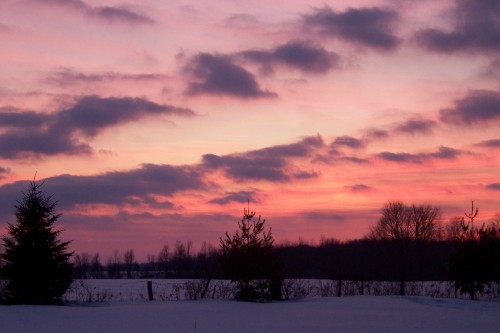
Posted in Misc on February 28, 2009| Leave a Comment »
The land is flat and open around here, making for a great view of the sun setting every evening. Here’s a particularly nice sunset from earlier this month, on February 6th.

Posted in Horses, tagged Arabian horse, Gleannloch, Morafic on February 27, 2009| 4 Comments »

We purchased Mousie from a young woman in the Arthur area about 10 years ago. She was 5 years old at the time. As is the case with many white horses, she was a darker colour when she was young, a pretty dappled grey. Her father was pure white, and over the years Mousie gradually turned white too. Actually, her colour is called flea-bitten, meaning she has freckles of brown dispersed through her coat. Mousie was supposed to be Ponygirl’s horse, but somehow their personalities just didn’t click. I however, fell in love with this sweet little mare. She’s my favorite horse ever.
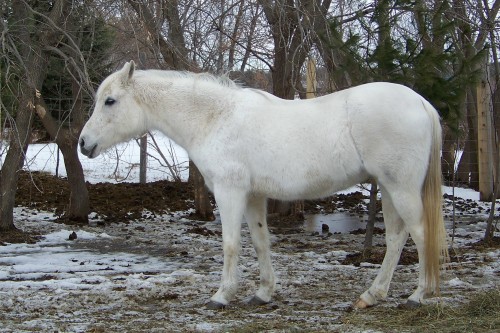
Mousie is a purebred arabian. Her registered name is SN Mazourka. It’s funny that her farm initials are SN. They stand for Sara Noel, the name of her previous owner, but my initials are SN too. It’s like we were meant for each other. You can see her pedigree here
Her most illustrious ancestor is her great-grandsire, Morafic. Morafic was imported from Egypt to Gleannloch Farm in Texas and went on to become one of the top Egyptian-bred sires ever. There is a statue commemorating Morafic where he once lived. Sadly, Gleannloch Farm is now…you guessed it…a housing development.

Morafic
Mousie’s not very big, probably just over 14 hands (a hand is 4 inches and horses are measured at their withers, the highest point of the back). What she lacks in size, she makes up for in intelligence and spirit. Although easy-going most of the time, there is nothing she loves more than a game of tag. You’re IT and she is happy to gallop around and around you, snorting, nose in the air, tail held high.

Arriving at Willow House, Nov 2008
She feels the cold, and the sub-30 degree days we had this winter really chilled her. She wore two winter blankets for quite a few weeks. However, with March approaching, the end of winter is just around the corner and we’re both looking forward to spring. We have new territory to explore and hopefully we’ll be out riding again soon. Here we are with Ponygirl and her horse, Diva, last year.
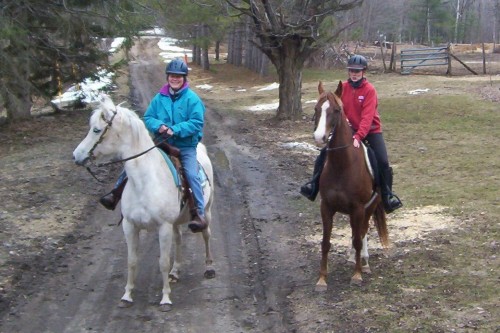
Mousie and Diva
Posted in Storyline, tagged firewood, Outdoor wood burning furnace on February 24, 2009| 3 Comments »

It is said that firewood warms the user several times over as you cut it, split it, stack it, and finally burn it. It is certainly true that feeding Garden Monster warms me several times over. One of those occasions is when a truckload of wood is delivered. The mountain of wood needs to be moved to the shelter of the covered hoophouse, close to the wood burner.

I move the pile one wheelbarrow load at a time. It is a rather monotonous undertaking.
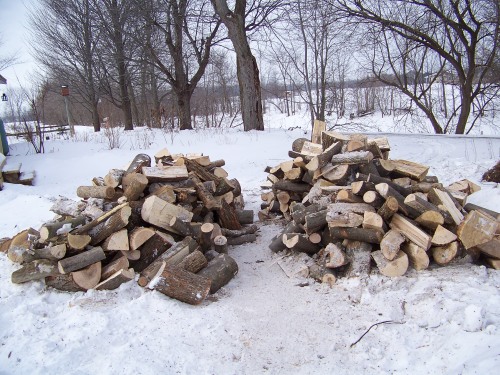
Going...
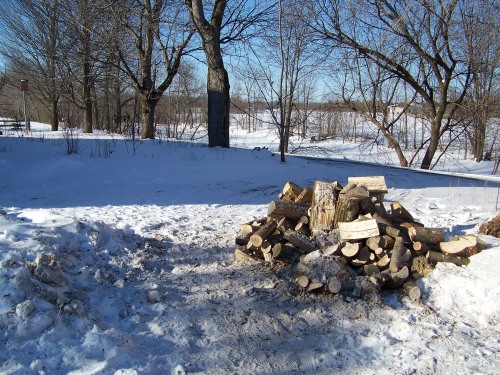
Going...

Gone.

Order
Posted in Books on February 23, 2009| Leave a Comment »

Emotionally Weird: A comic novel by Kate Atkinson. Doubleday, 2000.
Kate Atkinson is one of my favorite authors. This wasn’t my favorite book. I prefer her three novels featuring ex-cop turned PI Jackson Brodie: Case Histories, One Good Turn, and her most recent, When Will There Be Good News?. I also enjoyed her first novel, Behind the Scenes at the Museum. Still, it’s impossible not to enjoy any of Kate Atkinson’s writing.
The plot of Emotionally Weird revolves around a week in the life of narrator Effie Andrews as she attends university in 1972 Dundee. The large cast of characters, fellow students, professors and sundry others, serves as a platform for a waggish send up of academia. You don’t really need a story to appreciate the wit that pervades every page. A typical passage is this encounter between aging Professor Cousins and Professor McCue as the former wanders into a seminar session:
Kevin was saved from Gramsci by Professor Cousins, who wandered into the room at that moment. He caught sight of Archie [McCue] and seemed confused.
‘Looking for something?’ Archie asked, rather impolitely, and under his breath muttered, ‘like your brain perhaps?’ Professor Cousins appeared to be even more puzzled. ‘I don’t know how I ended up here,’ he laughed. ‘I was looking for the toilet.’
‘You found it,’ Terri murmured, without apparently opening her mouth, or even waking up.
Professor Cousins was English – an affable, rather eccentric person who had recently taken his first tottering steps into dotage. Sometimes Professor Cousins was lucid, sometimes he wasn’t, and as with anyone in the department, it wasn’t always easy to distinguish between the two states. The university’s strict laws on tenure dictated that he had to be dead at least three months before he could be removed from behind his desk.
Atkinson also offers many pleasing and evocative passages, exemplified by this line:
When Terri opened the window to retrieve the wine, flakes of snow flew inside and fell on us like cold confetti tossed by an unseen hand.
The events of Effie’s week are intertwined with a second narrative, a conversation between Effie and Nora, her mother-who-is-not-her-mother, as the latter recounts the circumstances of Effie’s family background. A third story is introduced in the guise of Effie’s creative writing project, a mystery novel. Effie’s own mysterious family history is resolved in the final chapters, and loose ends regarding the multitude of characters are tied up nicely in an update posted as 1999.
Rating: Four stars out of five.
Posted in Horses, tagged hay, Horses on February 22, 2009| 4 Comments »

New hay arriving
Horses eat a lot of hay. What seems like an inexhaustible supply when you first fill your hay mow is whittled away, day by day, until before you know it, it seems, that mountain of hay has disappeared and you need more. Friday was hay day. A new supply of 150 bales arrived to restock the hay mow. It should last until the new hay is cut in June. The first hay of the summer is a wonder. The glorious scent of it! Good enough to eat! Lovely, grassy green. By midwinter, the scent has mostly disappeared and the hay is beginning to brown.
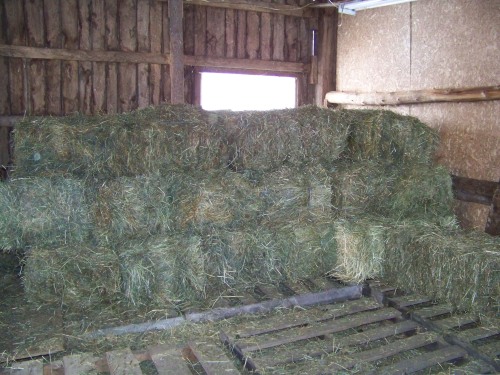
Stacking is heavy work. I’m not very good at stacking above my waist level, but I schlepped my third of the bales into the barn and worked on the lower levels. Good exercise. One hundred percent of the unstacking will fall to me. That’s the easy part.

A good quality of hay is important for horses. They have more delicate digestive systems than cows, having just one stomach to a cow’s four. When something goes wrong, it can result in colic, a potentially life-threatening emergency. Dust and mildew in the hay can also cause respiratory problems.

Here is Louie accepting a sample from Ponygirl, while Mousie looks on. Another satisfied customer.
Posted in Cats, tagged Abandoned Cats Rescue, PetSmart on February 20, 2009| 7 Comments »

One summer, a few years ago, people driving along our sideroad would catch glimpses of kittens running off into the bush as they drove by. It became apparent that someone had dumped a mother cat and her brood of little kittens off at the side of the road and deserted them. The spot was about a kilometer from our home, and it took several weeks, but eventually that cat and her surviving kittens traversed the fields and forests and arrived at our property. The cat probably settled on our place because, unlike most rural people, we didn’t have a dog. That was how Momcat became a part of our lives. We were able to catch her kittens, but Momcat had become both wary and wily, and several more summers went by before we were able to catch her. Each summer brought new kittens as well. Momcat was a terrific mother. Chipmunk was her favorite baby food, and she decimated the chipmunk population for a while. Finally, we were able to coax her into the house. Here is her last litter:

The whole kitten caboodle
Four of these kittens found homes with the help of a cat rescue organization, aptly named Abandoned Cats Rescue, and the PetSmart adoption program.
Two of them went home with Themarvelousinnature. Here are Oliver and Merlin:

Merlin and Oliver
Two kittens from a previous litter found a home with Ponygirl. Here are Tibby-Tabby and Maverick:

Maverick and Tibby-Tabby, birdwatching.
When Momcat’s last litter was weaned, Momcat visited the vet and was spayed. She moved with us to Willow House, where she has taken over the cat-house-on-stilts and peacefully whiles away many days gazing out the window from its roof. She only rarely allows herself to be petted. On those occasions, she stands just at the limit of hand-reach, apparently saying “I want to be petted, but don’t touch me!”. She seems to be enjoying something of a second kittenhood, and has playful moments as exhibited in this shot of her playing with the dangly toy on her house. On the whole, she seems very content with her new, carefree life as an indoor cat.

Posted in Animal life, Environmental, tagged Mid-Escarpment highway, raccoon, roadkill, signs of spring, Wildlands League on February 19, 2009| 3 Comments »
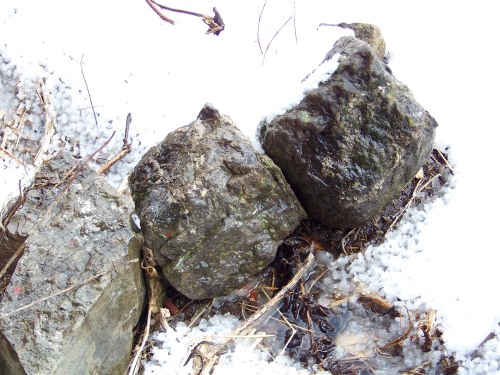
Yesterday’s snowfall has left a couple of inches of heavy, wet snow on the ground. Even though, with the temperature hovering around 0 C, snow is melting off the roof and splashing on these rocks near the door, we’re not likely to be seeing any snowdrops like those featured by Huckleberry, over at Huckleberry Days, any time soon.
When out driving yesterday morning, I did see one sure sign of spring on the roads: a dead raccoon. All winter long, raccoons spend most of their time holed away out of the weather, waiting for spring. When the warmer weather arrives, raccoons start searching for food and that’s when the annual raccoon catastrophe begins. Many end up under the wheels of a racing automobile. Opossums and other small animals also are at risk, but around southern Ontario, raccoons seem to be particularly susceptible. There is even a joke about it: Why did the chicken cross the road? To prove to the raccoon that it can be done.

Raccoon Catastrophe
Having raised several raccoon kits, I can attest to the fact that raccoons are very bright. But thousands of years of evolution has left them poorly equipped to deal with rushing steel monsters. Unlike animals such as rabbits, who use their lightening speed to save their lives, raccoons climb trees or, as fierce fighters, take a stand. These tactics don’t work well with cars.
The real problem isn’t the raccoons. It’s the roads. There are so many of them! They go everywhere. In southern Ontario, the network of roads has burgeoned since the car became king. The imperilment of raccoon lives is just one small cost of roads. Fragmentation, habitat destruction, and contribution to global warming are others. The Wildlands League has produced a publication that looks at the true costs associated with roads. It is titled Roads: More than Lines on a Map.
When it comes to paving over paradise, there is no end in sight. With city infrastructures crumbling, the limits to urban sprawl gaining recognition, and the need for improved public transit drawing attention, you’d think governments would have better things to do with our money, but we don’t seem to have turned that corner yet. One good example is the proposed Mid-escarpment Highway, an anachronistic plan left over from another era.
.
Posted in Misc on February 18, 2009| 2 Comments »

The February thaw, followed by freezing, sunny days, resulted in a slick, smooth ice surface on our little pond. Although I haven’t skated in years, this inviting skating rink was too good to pass up. I was going to take my old, rarely used skates out there….
Before I got around to that, the weather changed and today a snow storm is rolling in. As the snowflakes began to fall, I grabbed up my skates and took a quick whirl around the ice before it could be buried under a new layer of snow.

The redpolls are taking advantage of a last minute opportunity to stock up on seed before the storm hits.

The river, so recently in full flow, is going back to sleep. Winter has returned.

Posted in Storyline on February 17, 2009| Leave a Comment »

Willow House is situated on 65 acres. The forty acres at the rear of the property are forested. Sunday was a beautiful day, sunny, positively balmy for February. The thaw has melted away a lot of snow and what is left is compacted and frozen enough to walk on, so we decided a walk in the woods was in order. The trails through the forest were once used for taking out wood. They have been poorly maintained over the past few years, but are still clear enough to offer an easy hiking surface.
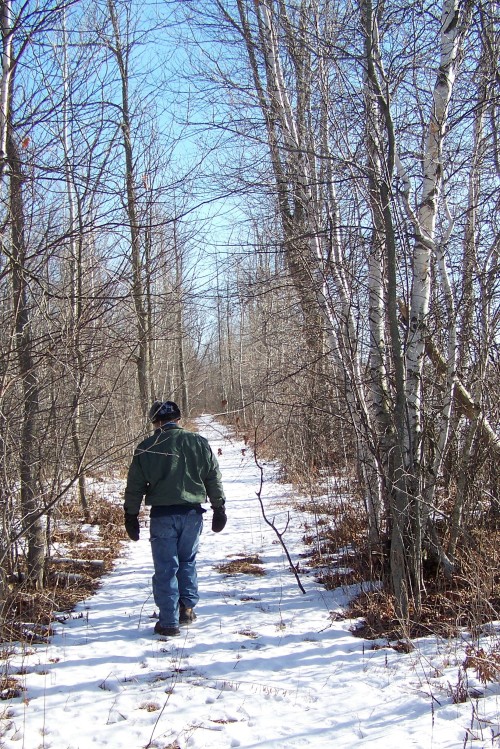
The winter woods have a tranquil and restful feeling, but the plentiful animal tracks and trails give evidence to the lives being lived beyond our gaze. Coyotes, foxes, raccoons, deer and squirrels had all left their marks, although the melting snow had distorted many prints. Here, the cloven hooves of deer have left deep impressions:

Wherever the snow had melted away, the bright green of Fan Clubmoss (Diphasiastrum digitatum) was visible. For Themarvelousinnature‘s take on this interesting and ancient plant, visit her blog entry here.

The forest has many young trees and few large, mature ones. Tree stumps and an occasional stack of firewood testify to the logging that has been done in the past.


One of the most majestic trees in the forest is this towering Eastern White Pine (Pinnus strobus), which was spared the woodman’s axe.

Posted in Birds, tagged American Crow, Branta canadensis, Canada Geese, Corvus brachyrhynchos, Jean Francois Millet, Meleagris gallopavo, The Gleaners, Wild Turkey on February 15, 2009| 1 Comment »
A news report in November 2008, told of a farm in Colorado that, once they were finished with the harvest, opened their fields to anyone who wanted to pick up the leftover vegetables. Forty thousand people showed up! These modern gleaners, arriving by car, were a far cry from Jean Francois Millet’s famous gleaners, portrayed in 1857.

The Gleaners, by Jean Francois Milet, 1857
Here are some local gleaners, photographed in fields in the surrounding countryside:

The Gleaners: Canada Geese (Branta canadensis)

The Gleaners: American Crows (Corvus brachyrhychos)
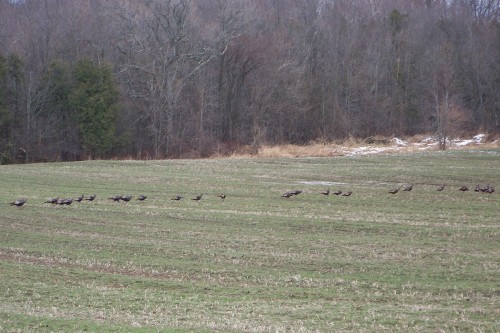
The Gleaners: Wild Turkeys (Meleagris gallopavo)